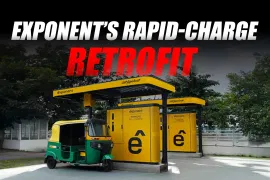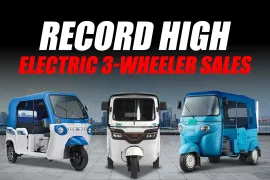The Mahindra Zor Grand Range+ and the Piaggio Ape Xtra LDX represent two different options in India's ever-growing last-mile logistics industry. One uses the power of a modern electric drivetrain, while the other depends on a conventional internal-combustion setup. Many businesses that juggle payload needs, cost control, and route patterns see these two vehicles as practical benchmarks. This article compares the two through design, performance and operational behaviour, while keeping the basics clear, compact and analytically grounded.
Powertrain and Design
The Zor Grand Range+ employs a small yet effective 12 kW electric motor connected directly to the rear wheels. The arrangement dispenses with the clutch and gearbox altogether; the result is that the motor's 50 Nm torque feels instant. The system draws its power from a 10.24 kWh lithium-ion battery pack, which charges to full in about 4-4.5 hours. Since the vehicle doesn't have engine vibration or gear shifts, its behavior remains predictable in tight urban corridors. Its certified range varies with test cycles but usually goes well beyond 100 km, and in some conditions pushes it past 150 km.
The Ape Xtra LDX, on the other hand, takes a mechanical path. The 599 cc diesel engine churns out approximately 9.4 hp with 23.5 Nm torque. The power delivery is managed by a manual gearbox, and the layout is similar for drivers who already drive diesel three-wheelers. Its fuel tank can hold approximately 10.5 liters, creating stable operating hours for long or continuous shifts. The lack of battery charging downtime provides it with flexibility in areas where access to EV charging remains spotty.
Performance, Payload and Handling
Because the Zor Grand Range+ relies on an electric motor, its acceleration remains smooth and low-speed control linear. It has a top speed of approximately 50 km/h, which is closer to short-haul logistics than open-highway driving. The rated payload hovers at about 400 kg, while the 11.5-degree gradeability enables the vehicle to climb moderate slopes with no apparent straining on the motor. Over dense city routes, these features align well with frequent-stop delivery cycles.
The Ape Xtra LDX presents another profile. With a payload capacity of approximately 496 kg, it bears heavier loads per trip. Its maximum speed touches around 60 km/h, and its gradeability, usually higher than 22%, keeps it on the move with better traction on steep or uneven ground. It is these characteristics that make it popular in industries regularly transporting large cargo or across hilly terrains where torque would be more important than noise or refinement. While the manual transmission involves greater driver effort, it does provide exacting control when under a load.
Running Cost and Operational Practicality
Electric drivetrains fundamentally change the cost equation. The Zor Grand Range+ doesn't carry any diesel or CNG costs, and its maintenance also goes down since no gearbox, clutch, or combustion engine is requiring routine servicing. Over multiyear use, many fleets report lower operating costs per kilometre, especially when the vehicle runs several shifts within a single day.
The Ape Xtra LDX brings advantages in infrastructure and not in cost. Its diesel or CNG fuel expenses fluctuate with market prices; even its mechanical components require periodic servicing. Still, refuelling is quick, and spare-part availability remains wide. For operators in areas where charging stations are limited or unreliable, this certainty offsets the higher running cost.
Which Vehicle Fits Which Business?
Businesses whose routes are generally dense-urban, tight-turn, heavy traffic, with frequent delivery stops, often find the Zor Grand Range+ better suited to their patterns; its low running cost, quiet operation, and gearless simplicity favor high-frequency, short-distance work.
Operators carrying heavier loads or running on longer and more varied routes may prefer the Ape Xtra LDX. Stronger gradeability, higher payload, and a broader fueling infrastructure make this a better choice in areas where reliability and load-carrying capacity are more important drivers of purchase than energy consumption or noise levels.
Both vehicles serve clear and distinct needs. The right choice depends less on the badge than on the operating environment: how far the vehicle travels each day, how heavy the cargo is, and how predictable the local charging or fueling network remains.
91Trucks is the place to go for all things commercial vehicles. If you need a new or used truck for your business, check it out. We have everything you need, from detailed reviews and exact specs to the best deals that fit your business needs. Stay up to date on the latest news, analysis, and stories from the business.
Follow us on Facebook, Instagram, and LinkedIn, and subscribe to our YouTube channel to get the latest news and videos from experts!
Read More
Web Stories
Latest Three Wheelers News
Categories
91trucks is a rapidly growing digital platform that offers the latest updates and comprehensive information about the commercial vehicle industry.









